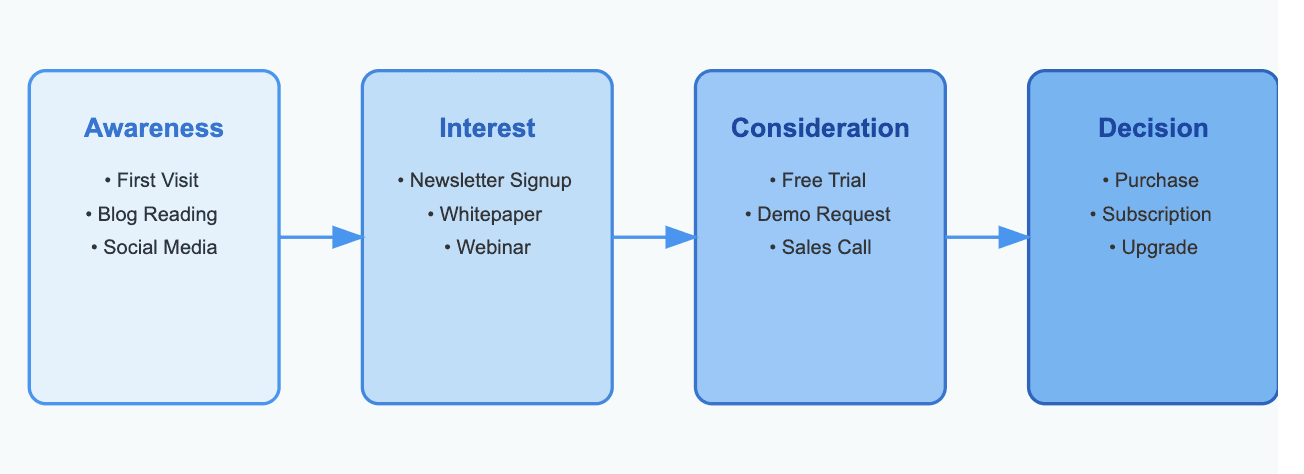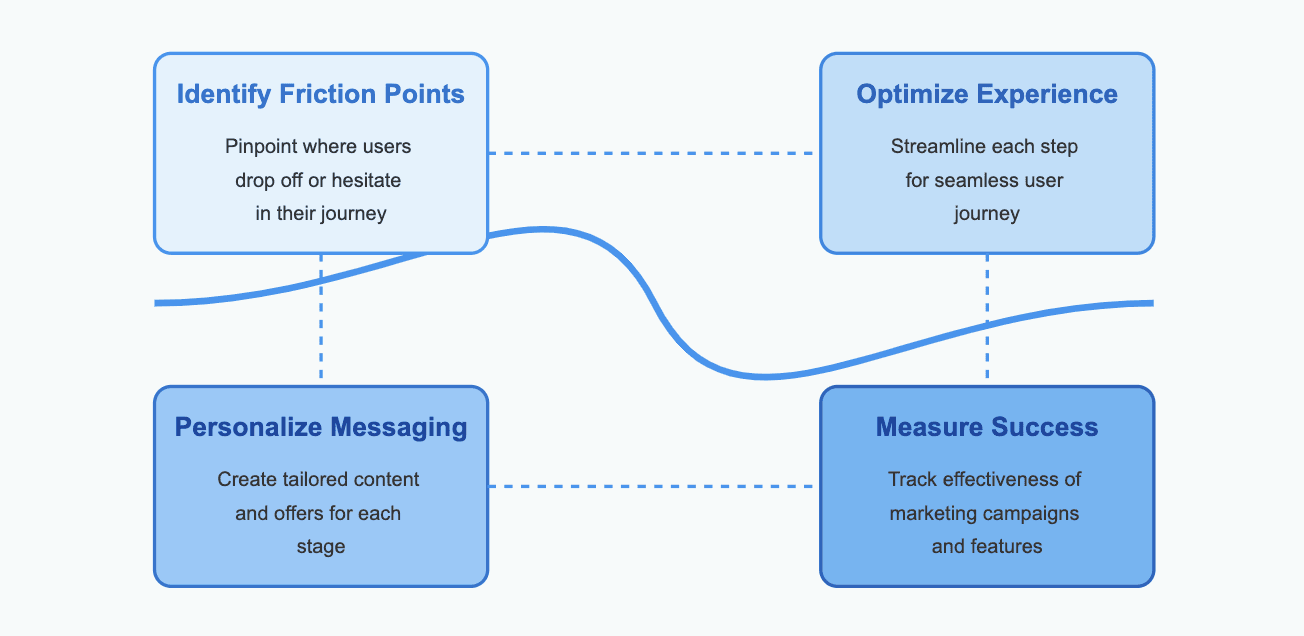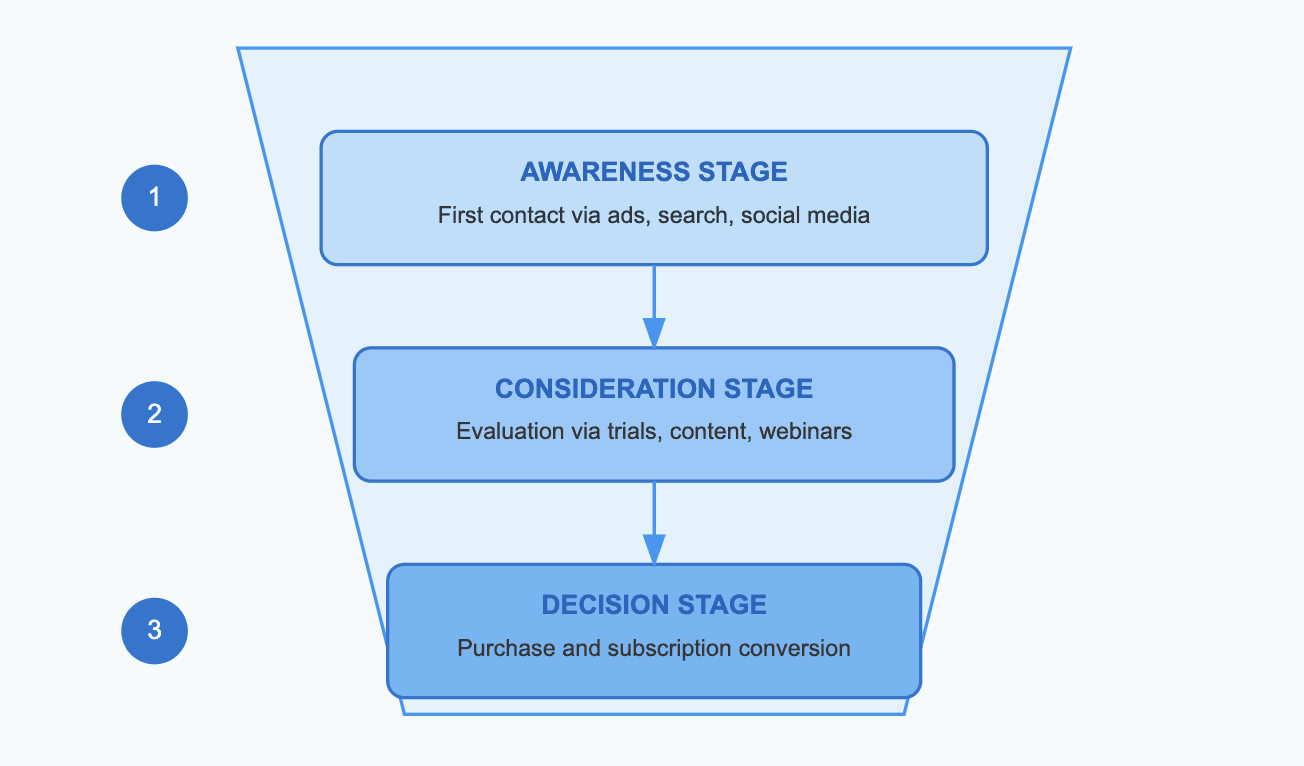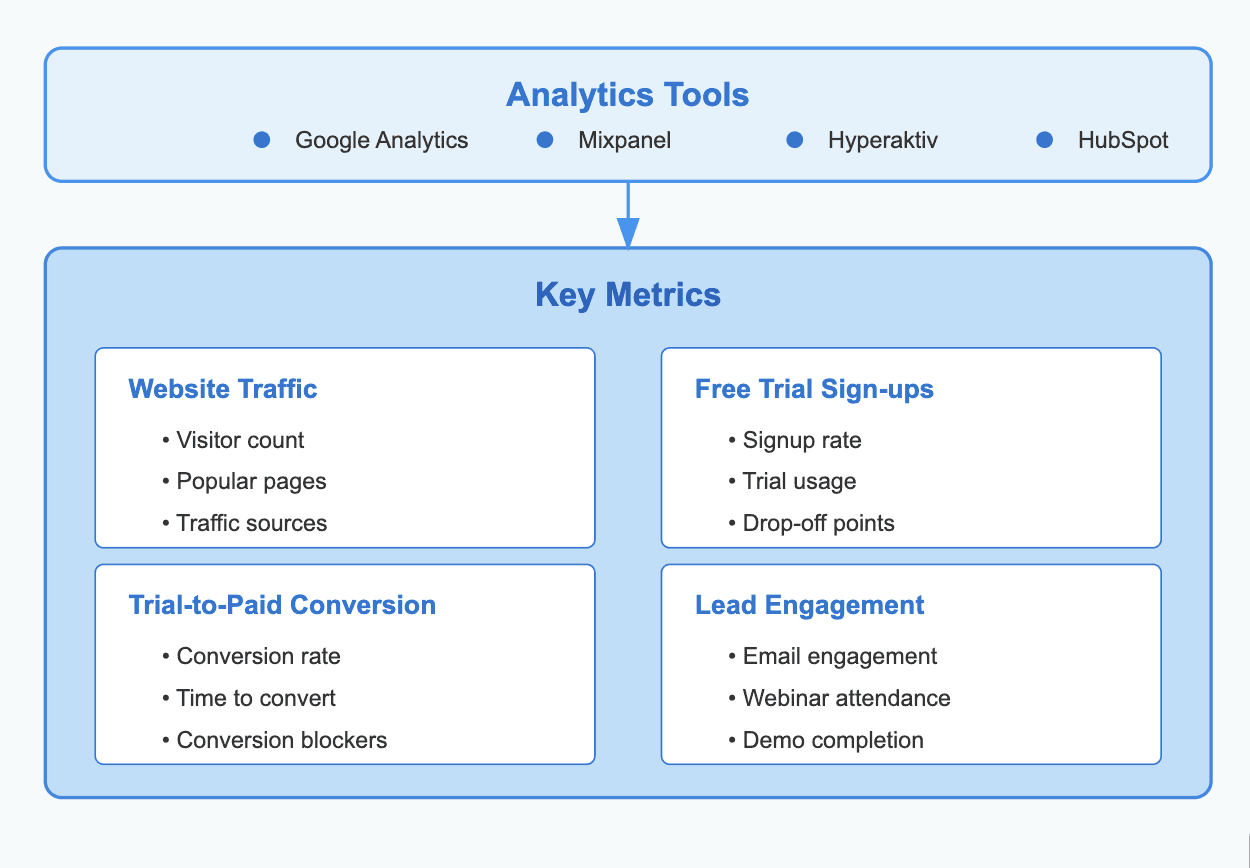
How to Map the Conversion Path in SaaS: 5 Steps

by
Wiktoria Slowikowska
Nov 20, 2024
Identify and convert your most valuable users
Sign Up
Understanding how users navigate your product—from first touch to becoming paying customers—is crucial. Mapping the conversion path is the key to optimizing this journey and ensuring a seamless, effective process that maximizes conversions and drives business growth. Whether you're looking to improve user onboarding, boost lead generation, or fine-tune your sales funnel, a well-mapped conversion path will provide the insights needed to enhance the customer experience and increase your bottom line.
In this article, we’ll walk you through the process of mapping the conversion path in SaaS, why it matters, and how you can use it to optimize every step of your users’ journey.
What is a Conversion Path in SaaS?

Before diving into how to map the conversion path, let’s clarify what it is. In the context of SaaS, a conversion path refers to the sequence of actions or steps a potential customer takes—from the moment they first learn about your product until they eventually sign up or make a purchase. These actions may include interacting with your website, engaging with content, downloading resources and participating in free trials.
Mapping the conversion path involves identifying these key touchpoints and understanding how leads move through each stage of their journey. The goal is to visualize the entire customer journey, pinpoint potential bottlenecks, and optimize each phase to increase conversions and maximize customer acquisition.
This process is not only about understanding the what but also the why behind each action a user takes. Why did a user visit your site? What motivated them to download a resource or start a free trial? What are the critical moments in the funnel when they might drop off, and how can you address those issues?
Why Mapping the Conversion Path Matters

In SaaS, the user journey is rarely linear. Users may come across your product via an ad, social media, a referral, or organic search. After that, they might explore your website, sign up for a free trial, and then eventually upgrade to a paid plan. Some customers may skip certain steps entirely, while others might linger in specific stages for a long time.
Mapping the conversion path helps you:
Identify friction points: By examining the entire journey, you can pinpoint where users drop off or hesitate, giving you the opportunity to address those issues.
Optimize user experience: Understanding the path allows you to streamline each step, ensuring a seamless experience that guides users toward conversion.
Personalize messaging and offers: With a map of your users’ journey, you can create tailored content, offers, and reminders that speak directly to their needs at each stage.
Measure the success of different tactics: By tracking how users navigate through the path, you can evaluate the effectiveness of marketing campaigns, product features, and sales efforts.
By mapping your conversion path, you can ensure that each stage is working optimally to drive your users closer to a successful conversion.
Steps to Map the Conversion Path in SaaS
Mapping a conversion path involves breaking down the customer journey into distinct phases and understanding the actions that lead to conversion. Here’s a step-by-step guide to help you map the conversion path for your SaaS business.
Step 1: Identify Key Stages in the Conversion Funnel

The first step in mapping the conversion path is to identify the stages in your conversion funnel. A typical SaaS conversion funnel has three primary stages:
Awareness: This is the first point of contact, where potential customers first learn about your SaaS product. They may discover your product through ads, search engines, social media, or word of mouth. At this stage, they are often unaware of your solution’s value.
Consideration: In this stage, leads are actively evaluating your product. They may sign up for a free trial, read blog posts, download eBooks, or attend webinars. They are weighing your product against competitors and deciding if it's a good fit for their needs.
Decision: This is the final stage where users decide to convert and make a purchase or sign a subscription agreement. This is where the magic happens, and your goal is to turn a prospect into a paying customer.
Understanding these stages is critical for crafting an effective conversion path. But not all customers will follow the same path, so it’s essential to tailor your strategies based on the different ways people move through the funnel.
Your goal is to create a roadmap that tracks user movement through these stages, identifying critical touchpoints that lead from one to the next.
Step 2: Map the Key User Actions in Each Stage
Once you've identified the key stages of the funnel, it’s time to pinpoint the specific actions that users take at each stage. These actions will help you understand the customer’s mindset and what they need to do to progress through the funnel.
Awareness Stage: At this point, your users are gathering information. They may take actions like:
Visiting your website
Reading blog posts or case studies
Following your brand on social media
Watching product videos or reviews
Signing up for a newsletter
Consideration Stage: Leads are actively considering your product in this stage. Key actions might include:
Signing up for a free trial or freemium version
Participating in a live demo or webinar
Downloading a product guide or other in-depth content
Comparing features or reading reviews
Engaging with customer support or a sales rep
Decision Stage: In this stage, leads are ready to make a purchase decision. Key actions at this stage may include:
Upgrading from a free trial to a paid plan
Speaking with a sales representative or customer success team
Applying a promo code or taking advantage of a special offer
Finalizing subscription details and payment
Mapping these key actions allows you to align your marketing and sales efforts with the user’s current needs and mindset. This also helps you identify which actions are critical to driving the user forward in their journey and where they may need additional motivation or support.
Step 3: Analyze User Behavior and Identify Touchpoints

To create an accurate map, you need data that tracks user behavior across each stage. This is where tools like Google Analytics, Mixpanel, Hyperaktiv, or HubSpot can be incredibly useful. These tools allow you to track user actions, identify patterns, and pinpoint where users drop off in the process.
Look at the following metrics to analyze behavior:
Website traffic: How many users visit your site, and which pages are most popular? This helps you understand what content is driving awareness.
Free trial sign-ups: How many users sign up for a free trial or freemium plan? This indicates interest and engagement in the consideration phase.
Trial-to-paid conversion rates: What percentage of trial users convert to paid customers? This tells you how well your product or service meets their needs and whether your onboarding process is effective.
Lead engagement: Are users engaging with your marketing materials, like email campaigns, webinars, or product demos?
Once you have this data, you can pinpoint friction points. For example, are users abandoning their free trial after only a few days? Perhaps they don’t fully understand the product’s value, and you need to provide better onboarding or guidance. Alternatively, if a large number of visitors are leaving your site at the same page, you might need to optimize that page’s design or content.
Step 4: Optimize Each Stage of the Path
Now that you have mapped out the conversion path and analyzed user behavior, it’s time to optimize each stage of the journey. Your goal is to reduce friction and guide users smoothly from one stage to the next. Here are some ways to optimize:
Awareness Stage:
SEO: Optimize your website for search engines to attract users who are actively looking for solutions.
Content marketing: Provide valuable resources like blogs, eBooks, and videos that inform and educate potential customers.
Paid ads: Use paid campaigns (Google Ads, Facebook Ads, etc.) to increase visibility and drive traffic to your site.
Referral programs: Encourage your current customers to refer new users, making them feel part of your brand's growth.
Consideration Stage:
Free trials: Make your free trial as seamless and accessible as possible. Use in-app messages or email reminders to encourage engagement.
Webinars and demos: Offer live demos or on-demand webinars to help potential customers understand how your SaaS can solve their specific problems.
Customer testimonials: Showcase case studies and success stories to build trust and credibility. Social proof can be a powerful motivator during this stage.
Personalized follow-up: Send personalized emails or offers based on the user’s activity, reminding them of the value your SaaS can provide.
Decision Stage:
Clear pricing: Make sure your pricing page is easy to understand and highlights the benefits of each plan.
Special offers: Provide time-sensitive discounts, extended trials, or other incentives to encourage conversions.
Sales assistance: Offer personalized help from your sales or customer success team to address any final questions or objections.
Risk reduction: Offer guarantees, such as money-back guarantees or free trials, to reduce any hesitations in committing.
Step 5: Test and Iterate
Mapping your conversion path is an ongoing process. It’s important to continually test, measure, and iterate based on user feedback and data. Use A/B testing to experiment with different strategies, such as messaging, pricing structures, and user interface changes. Monitor conversion rates and look for opportunities to refine each step of the path.
Regular testing also helps identify new opportunities for improvement, ensuring that your SaaS product stays relevant and continues to meet customer needs effectively.
Tools for Mapping the Conversion Path
To make the process easier, you can leverage a variety of tools that will help you track and analyze user behavior:
Google Analytics: Track website traffic, user actions, and funnel performance.
Mixpanel: Gain insights into user engagement and conversion behavior.
Hyperaktiv: Get insights into user behavior, segment users and send personalized messages.
HubSpot: Manage leads, track interactions, and automate marketing campaigns.
Hotjar: Understand user behavior through heatmaps and session recordings.
Continuous Improvement is Key
Mapping the conversion path in SaaS is essential for understanding how potential customers move through their journey and for optimizing every touchpoint along the way. By identifying key stages, analyzing user behavior, and making data-driven improvements, SaaS businesses can increase conversions, reduce churn, and improve overall customer satisfaction.
Remember, the conversion path is never static. As your product evolves and customer needs shift, so too should your conversion strategy. Keep testing, refining, and optimizing to ensure you’re offering the best possible experience for your users—and ultimately, driving more conversions.





